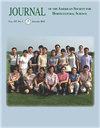Floral Aromatics of Ptelea: Chemical Identification and Human Response
IF 1.1
4区 农林科学
Q3 HORTICULTURE
Journal of the American Society for Horticultural Science
Pub Date : 2022-01-01
DOI:10.21273/jashs05119-21
引用次数: 0
Abstract
Many members of the citrus family (Rutaceae) are valued for the aromatic compounds emitted by their flowers. Ptelea species are unusually cold-hardy members of the Rutaceae, but conflicting descriptions of the fragrance of their unisexual flowers may discourage the use of these trees. We analyzed floral volatiles and human response to these chemicals to test the hypothesis that the fragrance of staminate and pistillate flowers of these species differs. Gas chromatography and mass spectrometry showed that most volatile chemicals emitted by flowers of Ptelea trifoliata and Ptelea crenulata are monoterpenes, sesquiterpenes, and esters. Most volatiles were emitted from flowers of both sexes, but ethyl benzoate and estragole were emitted only from pistillate flowers. When concentrations of aromatics differed between sexes, they were higher for pistillate flowers, except for cis-3-hexenyl butanoate and an unidentified terpene. For P. crenulata and P. trifoliata, respectively, 81% and 77% of survey responses were from volunteers who liked the fragrance. Panelists most frequently described the scent of flowers of P. crenulata of both sexes with the words citrus, lime, and sweet. Panelists distinguished between pistillate and staminate flowers of P. trifoliata, describing the odor of pistillate flowers most frequently with the words damp-earthy, spicy, and sweet; staminate flowers were perceived as light, fresh, grassy, and pleasant. This work represents the first analysis of floral volatiles of P. crenulata and resolves conflicting prior reports regarding the floral fragrance of P. trifoliata. We conclude that differences among people rather than the sex of flowers account for conflicting prior reports of floral fragrance. The scents of flowers of P. crenulata and P. trifoliata appeal to most people and are horticultural assets of these trees.Ptelea的花香气:化学鉴定和人体反应
柑橘科(芸香科)的许多成员因其花朵散发出的芳香化合物而受到重视。蕨类植物是芸香科中异常耐寒的植物,但对其单性花香味的描述相互矛盾,可能会阻碍这些树木的使用。我们分析了花的挥发物和人类对这些化学物质的反应,以检验这些物种的雄蕊花和雌蕊花的香味不同的假设。气相色谱和质谱分析表明,三叶和细齿叶花朵中释放的挥发性化学物质主要为单萜、倍半萜和酯类。大多数挥发物是从两性花中释放的,但苯甲酸乙酯和雌二醇仅从雌花中释放。当芳香族的浓度在性别之间不同时,除了顺式-3-己烯基丁酸酯和一种未鉴定的萜烯外,雌蕊花的芳香族浓度更高。对于P.crenulata和P.trifoliata,分别有81%和77%的调查回复来自喜欢这种香水的志愿者。小组成员最常用柑橘、酸橙和甜味来描述两性花的气味。小组成员区分了三叶草的雌花和雄蕊花,用潮湿、泥土、辛辣和甜味来描述雌花的气味最常见;雄蕊花被认为是轻盈、新鲜、长满青草和令人愉快的。这项工作首次分析了细齿苋的花挥发物,并解决了先前关于三叶草花香的相互矛盾的报道。我们得出的结论是,人与人之间的差异,而不是花的性别,是先前关于花香的报道相互矛盾的原因。桔梗和三叶草的花香吸引了大多数人,是这些树木的园艺资产。
本文章由计算机程序翻译,如有差异,请以英文原文为准。
求助全文
约1分钟内获得全文
求助全文
来源期刊
CiteScore
3.80
自引率
0.00%
发文量
31
审稿时长
2 months
期刊介绍:
The Journal of the American Society for Horticultural Science publishes papers on the results of original research on horticultural plants and their products or directly related research areas. Its prime function is to communicate mission-oriented, fundamental research to other researchers.
The journal includes detailed reports of original research results on various aspects of horticultural science and directly related subjects such as:
- Biotechnology
- Developmental Physiology
- Environmental Stress Physiology
- Genetics and Breeding
- Photosynthesis, Sources-Sink Physiology
- Postharvest Biology
- Seed Physiology
- Postharvest Biology
- Seed Physiology
- Soil-Plant-Water Relationships
- Statistics

 求助内容:
求助内容: 应助结果提醒方式:
应助结果提醒方式:


